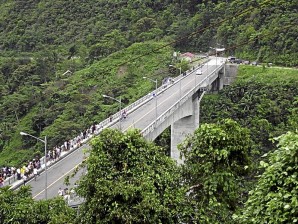
CABLES for the 1.5-kilometer zipline passes over the Agas-Agas Bridge, the tallest bridge in Southern Leyte. JANI ARNAIZ
SOGOD, Southern Leyte—Agas-Agas, which stands at 84 meters, making it the country’s highest bridge, is in trouble.
Heavy rains in the Eastern Visayas area during the past 12 months have resulted in landslides, eroding the protective covers of the two piers or columns of the 350-meter-long structure, built from Nov. 17, 2006, to Aug. 2, 2009, by the Arroyo administration with a P1.24-billion funding from the Japan International Cooperation Agency (Jica).
“The scouring that occurred were only about 10 meters apart from both bridge piers,” said a recent report of the Department of Public Works and Highways (DPWH) head office in Manila.
Citing a report of the DPWH office in Region 8, the agency noted that “previous preventive measures applied on the structure, such as gabion flood controls and drainage canals, have also been washed out.”
If neglected, these adverse conditions could seriously ruin the foundation of the superstructure, Public Works Secretary Rogelio Singson has warned.
To protect the bridge from imminent damage, the department has set aside P46.63 million for the plan and program of work designed to protect the stability of the structure.
The DPWH had scheduled a public bidding for the Agas-Agas bridge project early this month in Maasin City, the Southern Leyte capital.
Late last year, the agency spent about P9 million for protection and maintenance works on the structure.
Rolando Asis, DPWH-Eastern Visayas director, told the Inquirer that these emergency measures were the first to be taken to restore and rehabilitate the foundation of the bridge. He stressed the need for prompt protection works on the bridge’s piers.
When interviewed, Ma. Margarita Junia, Southern Leyte district engineer, recalled that they detected the problem during an inspection of the structure sometime in August.
“Along with a team of engineers, we found Agas-Agas bridge piers 1 and 2 exposed to damage risks. The ground where both piers are rooted had scoured or eroded. We also discovered that the access road to the area underneath the bridge had collapsed,” she told the Inquirer.
Assistant district engineer Allan Eway observed that the scouring is “more severe in pier No. 2, the one in the north.”
His colleagues—Vincent Sy III and Gideon Sacro—agreed, saying that if left unattended, the bridge’s piles will be exposed and may cause the bridge to be unstable.
“If no immediate protection works are done on the foundation, the piers will weaken. If that happens, we’ll have no choice but to temporary close the bridge to traffic to give way to the needed rehabilitation of the structure,” said Eway.
According to Junia, the bridge piers’ protection works is expected to start during the first quarter of 2015.
She expressed confidence that the province will experience good weather so the protection works could be completed as soon as possible. Her staff pointed to the “wet to very wet weather” in the region as one of the major causes of delays in the implementation of road and other state infrastructure projects.
Located in Barangay Kahupian, the Agas-Agas bridge is a 90-minute drive from Tacloban City in Leyte province. Sogod town, on the other hand, is 62.4 kilometers from Maasin City.
The bridge used to be one of the top attractions of the province—if not the region—with tourism amenities like a cable car, zip line and bungee jumping, among other extreme sports activities. However, these are no longer operating.

